#increase in major hurricanes
Explore tagged Tumblr posts
Text
okay the thing with the coast poll is that my tags were mostly joking cuz I do expect it to be a contest of where you've lived and I respect that so I'm not actually mad HOWEVER I saw some of the comments and as a person who has lived on both, I am thereby qualified to ask, IN WHAT FUCKING UNIVERSE IS THE EAST COAST MORE TEMPERATE. WHAT THE FUCK IS YOUR DEFINITION OF TEMPERATE.
#I lived in boston the winter of '15. do not fucking tell me that coast is TEMPERATE.#like yes you can comment that it's not as hot over there#(even tho imo higher temperatures are more tolerable on the west coast cuz it's lower humidity which is why it's better)#and also it used to be that it didn't even get hot enough that you needed a/c. MY PARENTS' HOUSE IN SOCAL STILL DOESN'T HAVE A/C.#but Y'ALL HAVE HURRICANES AND NOR'EASTERS. 'TEMPERATE' IS NOT ABOUT TEMPERATURE IT'S ABOUT STORM SEVERITY#we have SO FEW STORMS to the point that major storms COMPLETELY WRECK OUR INFRASTRUCTURE EVEN TO THE NORTHERNMOST POINT.#like this is also not about which coast is better I am just BEWILDERED BY HOW SOMEONE IS DEFINING TEMPERATE.#frankly wild too considering temperatures across the board are getting higher but the storms are getting WAY WORSE#BECAUSE OF THE TEMPERATURE INCREASES. CUZ THE WATER IS WARMING.#most new englanders I know like the east coast cuz they ENJOY the snow and are mad the snow patterns have changed.#anyway begging everyone to read more about climate change so you know how climates WORK TO BEGIN WITH
17 notes
·
View notes
Text
They can also show up in semi-inland spots like channels, even narrow ones.
Near where I grew up there was a looping channel around a small island, and the mouths of the channel went to the ocean. The mouths break up a lot of the waves and it's only maybe half a mile wide, so it's pretty calm looking, even when choppy.
Family was clamming on the island, I was feeling tired so I waded into the water to float, and picked the area that looked calmest. A few steps in, next thing I knew, I was dragged under so fast and so deep my ears ached for weeks, then was suddenly 15 or 20 feet out from shore.
Fortunately when I panicked, I did immediately go into float mode, and fortunately the rip current didn't go super far because of the location, but it's scary as hell and you'll never forget that lesson if you survive it.
As someone that has grown up surrounded by beaches and done surf life saving, I know how the sea works. Lots of people dont. Every summer multiple tourists die here because they don’t respect the sea, if you’re going to the coast, here’s a thing I saw on Facebook.
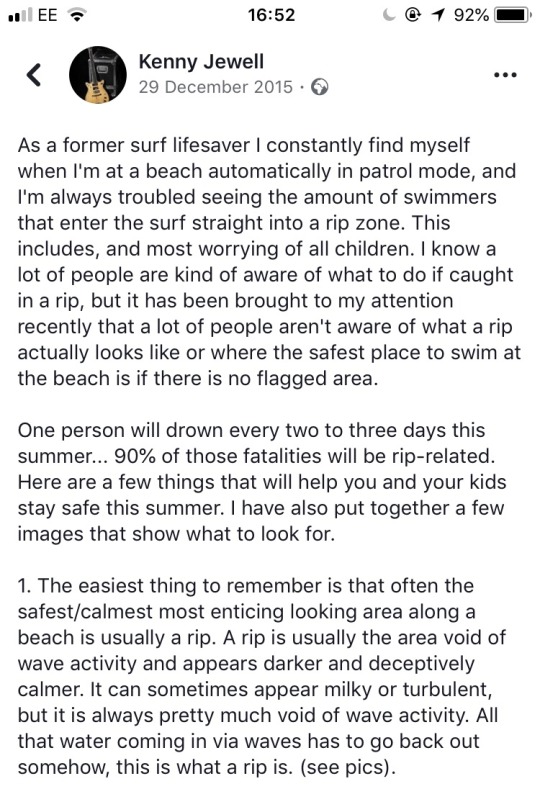
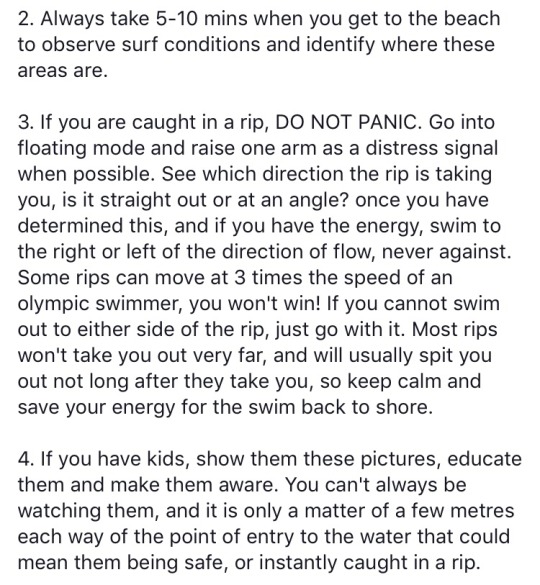
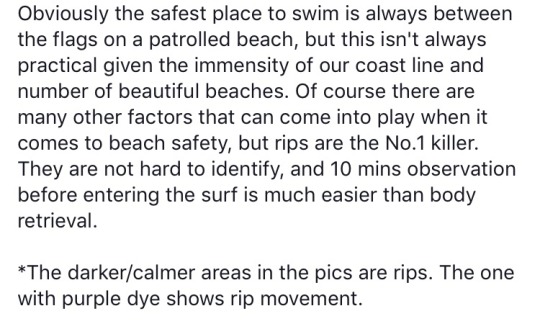
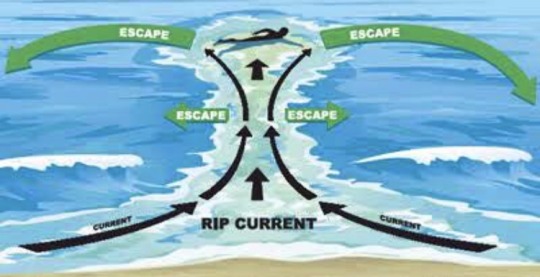
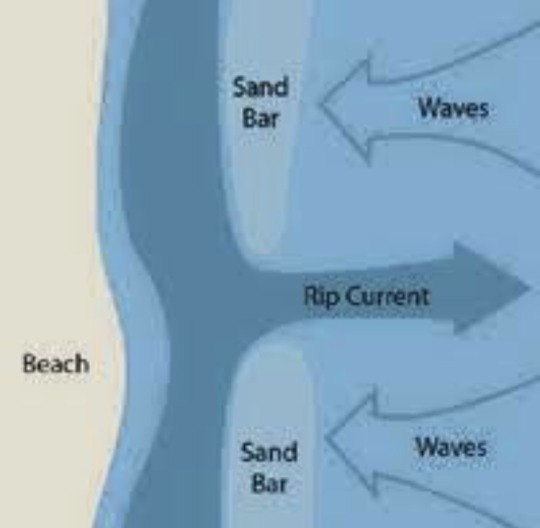

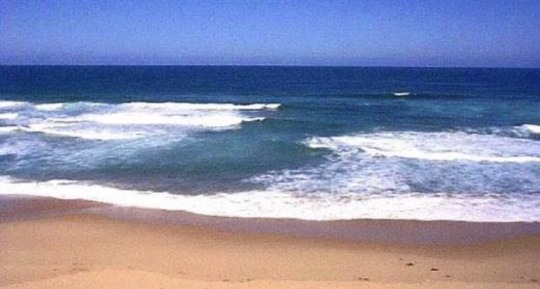

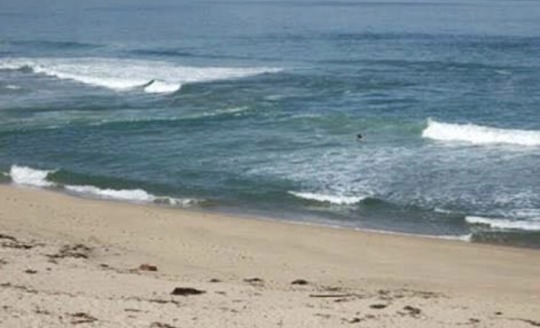

#misha rambles#also now I'm on the other coast and on a major river and i notice those treacherous calm spots there too#Idk exactly how far inland we are neither by crow nor river#Let's say 50-100miles to the coast and this big ass river (Columbia) definitely has rip currents#... also wrt the channel i mentioned... i haven't seen it for awhile but it's probably notably wider and choppier now#A few years before the story (which is a few decades afore today) a major hurricane ripped open the mouth on that side of the island#Ever since the erosion rate increased dramatically because of the extra strength coming in from the ocean
319K notes
·
View notes
Text
For over fifty years, NOAA has tracked extreme weather events, including tornadoes, hurricanes, and droughts. The database has provided the public, media institutions, and scientists a vital way of gauging the human and economic toll of our ever-shifting climate, with its unique pool of data that other institutions don't have access to.
But on Thursday, NOAA announced that it would stop updating the database beyond 2024, "in alignment with evolving priorities, statutory mandates, and staffing changes. All of its existing data is set to be archived.
To scientists, it's a gut punch.
"The NOAA database is the gold standard we use to evaluate the costs of extreme weather," Jeff Masters, a meteorologist for Yale Climate Connections, told The Guardian. "And it's a major loss, since it comes at a time when we need to better understand how much climate change is increasing disaster losses."
Since records began in 1980, the database has registered 403 of these destructive weather and climate disasters, exceeding $2.915 trillion in costs.
Grimly, the frequency of these events has steadily escalated, the database showed. Between 1980 and 2024, there were nine billion-dollar disasters each year on average. But in the past five years, CNN notes, the annual average has spiked to 24.
513 notes
·
View notes
Text
The Drake Passage
The Drake Passage (Mar de Hoces, pasaje de Drake, paso Drake) is the strait between the southern tip of South America (Cape Horn) and the northern tip of the Antarctic Peninsula (Prime Head, northernmost point of the Trinity Peninsula). It connects the Atlantic Ocean, in particular the Scotia Sea, with the Pacific Ocean and is part of the Southern Ocean, which is named after the English Free State of Scotland.

It was named after the English privateer Francis Drake (1540-1596), who, according to legend, discovered it by chance while sailing around the world in search of two escort ships that had drifted away in a storm. In retrospect, the naming was probably politically motivated, as it was only attributed to Drake around 20 years after his death and two years after the Dutchman Willem Cornelisz Schouten (1580-1625) crossed it.

The sea area was first navigated in 1616 by Willem Cornelisz Schouten, who originally named the Strait of Le Maire after Jakob Le Maire, the discoverer of Cape Horn. It is possible that the area was already travelled before Drake and Schouten by the Spanish captains Francisco de Hoces (1526) and Gabriel de Castilla (1603). For this reason, the sea route is often referred to as Mar de Hoces (Hoces Sea) in Spanish, Argentinian and Chilean sources. In Spanish, however, Estrecho de Le Maire refers to the passage between Tierra del Fuego and the Island of the States.
The Drake Passage is considered one of the most dangerous passages in the world due to various factors. Firstly, because of the extreme weather conditions: The passage is notorious for its fierce winds, which often reach hurricane force and more. These winds, combined with rapidly changing weather conditions, can lead to massive waves and violent storms that pose a considerable risk to ships.
Strong winds and currents in the Drake Passage can lead to exceptionally high waves that can reach heights of over 30 metres. These unpredictable waves pose a great danger to ships and can cause them to capsize or be severely damaged. Icebergs and ice floes are not as common in the Drake Passage as in the polar regions, but are still present, especially during the Australian summer. These floating obstacles increase the risk of collisions and damage to ships, especially in poor visibility or rough seas.
Although the Drake Passage is one of the widest ocean passages, it is relatively narrow and shallow compared to other major ocean passages. This can lead to rough and choppy seas, making navigation even more difficult and increasing the likelihood of accidents. The Drake Passage is also far away from major harbours or rescue facilities, so help can be slow to arrive in an emergency. The remoteness and inhospitable nature of the surrounding Antarctic region makes rescue even more difficult.
The currents in the Drake Passage are also dangerous: the Antarctic Circumpolar Current (ACC): This current flows rapidly from west to east around Antarctica. It is the widest and fastest ocean current in the world. It becomes even faster in the Drake Passage, making the seas turbulent and unpredictable.
Other currents from the Atlantic and Pacific meet in the Drake Passage. These include the Falkland Current from the north and the Westerly Current from the south. When these currents meet, they intensify the water flow and create eddies and turbulence.
Although the tidal currents are not as significant, they also have an influence on the Drake Passage. Although they are not as strong as in other places, they can still affect navigation, especially in combination with the strong ACC. These tidal currents can make navigation through the passage even more difficult.
Despite these problems, the passage is passable today.
83 notes
·
View notes
Text
Not Flirting

This is NOT FLIRTING.
The very fact that the media say "flirting" is indicative of the fact that the cultural ideas we have around value, improvement, morality, ability and functionality are *rooted* in a a framework which is ableist and eugenic in nature.
Fundamentally, the idea that there are "good genes" and "bad genes" is saying there are "good" forms of embodymindedness and "bad" forms, and that we should remove or reduce the bad and increase the good.
This is biopolitics which is at the root of 19th, 20th and 21st century processes and horrors, and is not *just* racist, but is one of the major ORIGINS of racism as it manifests today, as well as a wellspring of sexism, homophobia, transphobia, antisemitism, colonialism and capitalism.
We are enmeshed in the world eugenics and its proponents thought up, and wrought. It is so prevalent beneath the surface of how we relate to the world in terms of growth, progress, science etc, that we are like fish swimming in it.
This IS NOT JUST TRUMP. This is the ongoing pandemic, the manfacture of debility in marginalised populations for the benefit of those at the levers of power. This is the dismissal of Appalachian lives and folks in rural areas as low-intelligence inbred hicks who "should have known"/"should have moved" in the face of hurricanes. This the way standardised testing structures education on pass fail and grade curves. On and on, with countless more manifestations and iterations.
**We live in a eugenicised society.**
One that frames who should be improved, and how, on the basis of trajectories which begin by evalulating a being on how much it conforms to a certain set of criteria. We never ask where those criteria come from. We never consider that the liberal humanist agenda might also create folks who *don't fit*, in order to mark those who do.
We should. We should ask ourselves where "the human" even comes from.
[ID :A screenshot from The Guardian's liveblog coverage of the US Election, which reads: "Flirting with eugenics, Trump says: ‘We got a lot of bad genes in our country right now’ In an interview earlier today with conservative broadcaster Hugh Hewitt, Donald Trump used terminology associated with eugenics to attack migrants. The remark came as the former president discussed the alleged harm done by new arrivals to the United States, saying many were “murderers”. “Now, a murderer, it’s in their genes,” Trump continued. “And we got a lot of bad genes in our country right now.” It was language similar to the beliefs of eugenics, which emerged in the late 19th century and held that human ills could be combatted through selective breeding. The theory is today regarded as both inaccurate and racist."]
175 notes
·
View notes
Text
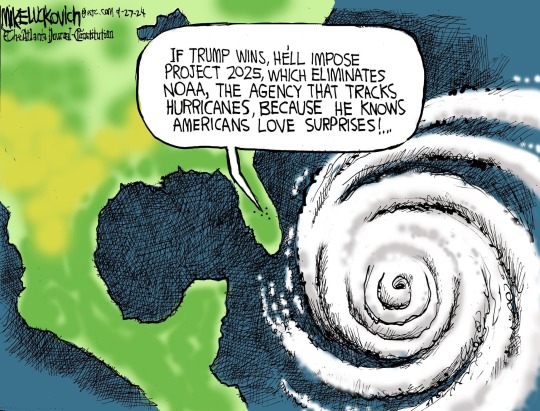
Mike Luckovich
* * * *
"Russia, Russia, Russia. It's always Russia!"
October 9, 2024
Robert B. Hubbell
On a day of major political stories, the Earth is reminding us that we are guests on this planet subject to our collective good behavior over the long term. Hurricane Milton is threatening Florida like no other storm in the last century. Millions are (wisely) evacuating in the face of strong winds and a record storm surge that will inundate coastal areas.
Two months ago, Trump joked about human-caused climate change creating “more beachfront property.” In 2021, 175 House Republicans and 35 Senate Republicans voted to defund FEMA. See MTN News, A Whopping 175 House Republicans Voted Against FEMA Funding in 2021. Many of those lawmakers are now criticizing FEMA for being overwhelmed and under-resourced. Last week, Speaker Mike Johnson refused to call a special session of the House to enact emergency supplemental funding for FEMA.
Jokes aside, the substantive policy of the Republican Party is to promote fossil fuels and undermine green energy. See Center for American Progress, Project 2025 Would Jeopardize Global Climate Action. One of Trump's first acts in 2017 was to serve notice that the US would withdraw from the Paris Climate Accords, and one of Joe Biden’s first acts was to rescind that notice. If Trump is re-elected, we should expect that Trump will again seek to withdraw from global efforts to fight human-caused climate change. See NBC News, Mike Johnson won't commit to bringing House back before the election for more hurricane relief.
The weather is not the climate and record-breaking weather events are not (in themselves) climate change. But acceleration in global climate trends over time are evidence of human caused climate change. Indeed, the tendency of hurricanes to rapidly increase in intensity—like Hurricane Milton—is part of a new trend in hurricane behavior. See NBC News, Hurricane Milton's rapid intensification is part of a climate-fueled trend.
Climate change is maddeningly difficult because its effects are difficult to track—until they are not. We may be living through one of those moments in which the effects of climate change are undeniably manifest. The question facing us is whether we have the capacity to maintain our concern and sense of urgency after the water has receded and the news crews have moved to the next breaking story. We need the ability to engage in long-term thinking and the patience to allow solutions to work over decades (or longer).
Many worthy and effective organizations are focused on fighting human-caused climate change. I have previously endorsed and appeared before Third Act, an organization started by Bill McKibben. Third Act describes itself as “a community of Americans over sixty determined to change the world for the better. Third Act harnesses an unparalleled generational power to safeguard our climate and democracy.” Check out Third Act—or highlight your climate focused organization in the Comments section.
In the meantime, my wife and I express our concern and empathy for the hundreds of thousands of Floridians affected by Hurricane Milton. Be safe and follow the guidance of authorities!
[Robert B. Hubbell Newsletter]
#Mike Luckovich#hurricane#FEMA#GOP lies#climate science#climate emergency#climate change#Robert B. Hubbell Newsletter#Robert B. Hubbell#Third Act#Bill McKibben#Hurricane Milton
96 notes
·
View notes
Text
Lawmakers in Hawaii have passed first-of-its-kind legislation that will increase the state’s lodging tax to raise money for environmental protection and strengthening defenses against natural disasters fueled by the climate crisis.
Hawaii’s governor, Josh Green, supports the creation of the so-called “green fee”, and is expected to sign it.
“This legislation, which I intend to sign, is the first of its kind in the nation and represents a generational commitment to protect our ‘āina [land],” Green said in a statement. “Hawai‘i is truly setting a new standard to address the climate crisis.”
The bill passed on Friday adds a 0.75% levy to the state’s existing tax on hotel rooms, timeshares, vacation rentals and other short-term accommodations. It also imposes a new 11% tax on cruise ship bills, prorated for the number of days the vessels are in Hawaii ports.
Officials estimate the tax will generate nearly $100m annually. They say the money will be used for projects like replenishing sand on eroding Waikiki beaches, promoting the use of hurricane clips to secure roofs during powerful storms and clearing flammable invasive grasses like those that fed the deadly wildfire that destroyed downtown Lahaina in 2023.
The state’s house and senate, both controlled by large majorities of Democrats, passed the measure by wide margins.
Experts say the bill is the first of its kind in the US.
Hawaii already levies a 10.25% tax on short-term rentals. As of 1 January, the tax will rise to 11%. Hawaii’s counties separately charge a 3% lodging tax, and travelers also have to pay the 4.712% general excise tax that applies to all virtually all goods and services. The cumulative tax bill at checkout will climb to 18.712%, among the highest in the nation.
Green, the governor, argued the increase was small enough tourists would not feel much of a difference. As many visitors travel to the state to enjoy the environment, he predicted they would welcome committing dollars to protect shorelines and communities.
“The more you cultivate good environmental policy, and the more you invest in perfecting our lived space, the more likely it is we’re going to have actually lifelong, committed travelers to Hawaii,” he told the Associated Press.
Zane Edleman, a visitor from Chicago, said he could envision the extra cost prompting some travelers to head elsewhere else, like Florida. But, he said, it would depend on how the state shares information about what it does with the money.
“If you really focus on the point – this is to save the climate and actually have proof that this is where the funds are going, and that there’s an actual result that’s happening from that, I think people could buy into it,” Edleman said.
The first draft of the legislation called for a larger increase, but lawmakers pared it back.
#excerpts#hawaii#climate change#us politics#i know there's plenty of Hawaiians who would be happy to see tourism taper off#can't blame them
20 notes
·
View notes
Text
Excerpt from this Conservation Works blog on Substack:
Michael Soulé, the founder of conservation biology, used to say that one of the most important pieces of advice he got as a young scientist was “when in doubt, count.” Monitoring — counting or otherwise measuring organisms in the same place over time — is the foundation of conservation biology, and in many ways it’s the foundation of conservation, too. Unless someone counts how many lizards, salmon, ferns, or species of butterflies live in a certain place, and repeats the count at regular intervals, that group of organisms can decline or even die out unnoticed. Before an organism can be conserved, it has to be counted.
But what’s the point of counting organisms that seem doomed to extinction? That’s the question tropical biologist Peter Edmunds addresses in a recent BioScience essay titled “Why keep monitoring coral reefs?”
For nearly four decades, Edmunds has been monitoring coral reefs at two locations in the U.S. Virgin Islands, using annual photographs to measure changes in the relative extent of coral and algae. He started the project in 1987, less than a year before the first known Caribbean-wide coral bleaching event; since then, coral extent at one of his sites has shrunk by 92 percent and at the other by 52 percent. Both reefs used to be dominated by boulder star coral, a large, stony species that provides structure to Caribbean reefs and protects the region’s coastlines from erosion. Now, they are dominated by fast-growing “weedy” corals and algae. Given that climate change continues to drive up water temperatures and increase the frequency and intensity of hurricanes, writes Edmunds, “the prospects for community recovery are bleak.”
Yet he argues that monitoring matters, and will continue to matter. The series of photographs Edmunds and his colleagues have accumulated, for instance, suggests that acute disturbances such as hurricanes and major bleaching events cause less damage over time than the everyday stress of rising water temperatures. Moreover, as he writes drily, “the past is an imperfect predictor of the future, ensuring that old data can never fully take the place of new information.” Even a grievously altered system such as the Virgin Islands reefs will continue to change in different ways for different reasons, and understanding those changes will be essential to protecting the life that persists — both at sea and on land.
I was reminded of Edmunds’ argument earlier this month, when I attended the Greater Yellowstone Ecosystem Biennial Scientific Conference, held this year in Big Sky, Montana. One of the speakers was Tom Olliff, an ecologist who, like Edmunds, has dedicated himself to one ecosystem: he spent 32 years living and working in Yellowstone National Park, eventually directing its Science and Resource Management Division.
Olliff noted the remarkable changes in and around Yellowstone during the course of his career, including the reintroduction of wolves, the recovery of grizzly bears, the boom in visitor numbers, and the excruciating and still-growing development pressure on private lands. He called on his listeners, who included many colleagues and friends, to undertake “audacious acts of conservation,” projects that take a long time to realize and may face determined opposition.
Olliff named some headline-grabbing audacious acts, like wolf reintroduction and dam removal. But he ended his talk with a quieter example. In his current position as a regional research manager for the National Park Service, he has been working with wildlife biologist Don Swann on the long-term monitoring of saguaro cacti in the Sonoran Desert of Arizona and Mexico. Though adult saguaros are still common, young saguaros are struggling to survive as temperatures rise. How long should scientists plan to monitor the population? Four decades from now, a report on the saguaro population might be as grim as Edmunds’ assessment of the Virgin Islands reefs.
37 notes
·
View notes
Text
Tropical storms and hurricanes have not increased in number or strength over the 50 years we've had satellites monitoring the weather. If CO2 were increasing the number of storms we'd be able to see if there is a noticeable trend.

This shows the number of tropical storms on the top line and the hurricanes on the bottom. There's no real trend on either.

This shows the accumulated cyclone energy (ACE). Global is on top and the northern hemisphere on the bottom.
ACE estimates the total energy involved in the named storm systems for each year. We can see some years were higher, some lower but again, there's no strong trend up or down.
The media and the global warming alarmists will repeat the usual nonsense about increasing numbers and intensity of storms after Beryl does its thing. They do it after every major storm and then they go quiet after every calm period.
It's one sided reporting to alarm the public and to skew perception to make you believe the world is ending, the weather is your fault, and the only cure is more government.
Source for the charts.
53 notes
·
View notes
Text
the media and California officials' focus on stopping "widespread looting" that is definitely, totally happening in the wake of the ongoing wildfires is the epitome of what i would expect from of this spiraling capitalist police state.
a curfew has been initiated and the National Guard has been deployed near the Palisades fire in Pacific Palisades, where over 10,000 structures have been totally destroyed and near the Eaton fire, which ignited in and burned down Altadena, a historically Black neighborhood.
now, when i say widespread looting, what i really mean is: a total of 20 arrests (not convictions) for burglary (or trespassing even) in a city of 3.8 million people. for context, Los Angeles had about 10,000 burglaries in the year 2024. this amounts to an average of 27 per day.
mind you, there has not been a single video, Ring camera footage or any other evidence of mass organized looting taking place anywhere in California. not only that, but the one instance of "looting" that has actually managed to go viral on social media was simply a Black guy evacuating his home in Altadena. his house number is even visible in the post, which was viewed by hundreds of thousands and now likely millions of people.
please understand: this is not to say people have not been taking advantage of this situation. i am 99.99% sure that evacuated homes have been broken into. perhaps even several! this still does not fit the definition of widespread looting and should not justify it being a large chunk of the coverage by the media.
but the most important part of this post will be what you can learn from all of the other times in history that we were told this was a huge problem and totally not racism or justification for further heavy-handed policing. for example:
Hurricane Katrina, where the incredibly damaging feedback loops of inflammatory coverage lead to the governor highlighting the National Guard's M-16's and saying "these troops know how to shoot and kill," as well as the below infamous photos from the Associated Press*.

Hurricane Harvey, where a photo in "Houston" showed a group of Black men looting a corner store that just so happened to be in my home town of St. Louis, Missouri, 800 miles away.
Hurricane Sandy, where Business Insider was warning people to prepare for a "wave of crime," only for there to be ~100 total arrests for looting in New York City, the majority of which were thrown out of court. 16 of those were arrested for "raiding a Coney Island Key Foods." the overall crime rate in New York dropped after Sandy.
the National Institute of Health addressed the mythology behind disaster looting in 2008 and 9 other common misconceptions. their findings on the topic were consistent with nearly every other sociologist or organization that has researched it:
It is commonly assumed that the social contract is tenuous at best and that major natural disasters and other crises trigger mass disruption, disorder, and social breakdown. While there were well-documented instances of brutal hijacking, rioting, and looting in New Orleans after the deep flooding caused by the hurricane, there were many more reports of altruism, cooperativeness, and camaraderie among the affected population. 8,25,26 The overall cooperative, prosocial, and altruistic individual and community response following Hurricane Katrina was similarly observed after the Asian tsunami of December 2004, and the July 7, 2005, terrorist bombings in London, 27 and may have been reflected in the transient 40% to 60% drop in the homicide rate in New York City after September 11, 2001. 28 In support of de Goyet's thesis, it is well documented that natural and man-made disasters are followed by increases in altruistic behavior and social solidarity. 29–32
do not allow the dangerous combination of cynicism and reactionary propaganda consume you. i fear there's more to come.
28 notes
·
View notes
Text
greasy gruesome newscum begging for your money after he pissed away over $100 BILLION of your tax dollars over the last 3 yrs
I wanted to send you a note about the fires happening in Southern California, and then at the end of this message, I'm going to ask you to make a contribution to the California Fire Foundation.
They are an organization that provides support to firefighters and the communities they serve, including direct financial aid to impacted residents.
First, an update on the fires:
We are putting all available resources behind fighting these wildfires, including leveraging local and federal assets. Hurricane-force winds have made this into one of the largest firefighting challenges in modern American history. President Biden immediately signed a major disaster declaration and has offered to help in any way he can.
Last week, when we saw the wind forecast and the increased fire risk, we pre-positioned assets – fire engines, airports, helicopters, bulldozers, water tenders and more – and as you read this, there are more than 10,000 firefighting personnel on the ground working to combat these fires.
Despite these preparations, the damage has been devastating. I’ve seen it with my own eyes over the past several days as I’ve walked through burned neighborhoods, accompanied by first responders.
This is going to be a long recovery process, but we will have impacted families' backs. That's not just rhetoric, we have unfortunately been in this situation before.
Now, if you'll allow me, let me add a few words about Donald Trump, as his allies lie about water policy and laugh about gay firefighters – while people are literally fleeing as homes, churches and schools burned down. It sickens me to my core.
You have probably heard the saying, "A lie can travel halfway around the world while the truth is putting on its shoes" – well, that is especially true right now. We will combat these politically motivated lies. But our focus today isn’t on meme wars, it’s on firefighting. And showing up for Californians who have lost everything.
So here's the part where I ask you to make that donation to support the heroes – the firefighters and first responders – whose sacrifice and determination have not only saved lives and livelihoods, but inspired the entire country.
Please use this link to make a contribution to the California Fire Foundation. It is a tax-deductible donation and the money will go directly to supporting firefighters and the communities they serve, including direct financial support to impacted residents.
If you've stored your info with ActBlue, we'll process your contribution instantly:Donate $3Donate $25Donate $50Donate $100Donate $250Other Amount
Thank you,
Gavin

PAID FOR BY NEWSOM FOR CALIFORNIA – GOVERNOR – 2022

ReplyForward
You can't react with an emoji to a group
14 notes
·
View notes
Text
Let’s talk a little bit about hurricanes!
Let’s discuss where the danger lies, individual preparedness, community preparedness, and mutual aid efforts around these storms and their aftermaths.
To start, the thing to remember about hurricanes is this: It’s not one disaster. It’s hundreds of different disasters at once.
Hurricanes have their own massive winds. They also spawn tornadoes. Hurricanes bring storm surges like tsunamis, but they also bring heavy rains, swelled rivers, broken dams. The vectors for flooding are multitudinous.
With any disaster, the danger isn’t always direct. While many people die die in the immediate storm, often the deaths continue to accumulate for months after. This is because people don’t just go on living just because the storm is over. All of us have lives that are dependent on infrastructure. Medical infrastructure, food infrastructure, social infrastructure, transportation infrastructure, electrical infrastructure. When any of these fails it can put strain on the rest. People go hungry, go lonely, their disabilities go untreated, injuries are more likely in the wreckage, they die of infection and disease and suicide because it seems so hopeless. So many become homeless, displaced, losing everything. And often there is nothing in the way of aid.
And bigotry can often exacerbate. white supremacist groups and police become vigilantes, killing those who scavenge the wreckage. Even in milder hurricanes, police violence and violence from store proprietors increases. Disabled people are often pushed out of hospitals to die at home. People are euthanized.
Hurricanes exacerbate the worst parts of the system of domination.
But they also bring out the best in communities and people who believe in caring for one another.
After every hurricane, tens of thousands of volunteers go out in their airboats to save people from the floods. People prepare food, develop water filtration. People open their homes to those who have fled, those who often have lost everything. These volunteer armies of aid workers are from all accross the south east, from many paths of life and from every conceivable part of the political spectrum. On the flat boats of the Cajun Navy, in their supply lines, you will see maga hats standing next to anarchist abolitionists, both concerned primarily with how they will get an old woman both just met her medicine. Months and years after the storm you will see flocks of children flittering like bees around stripped down homes, helping to remove what is tainted and rebuild towards home again, and they will be working aside those same people who helped in the immediate aftermath.
Even when government aid does come in, it is not the government that manages all of it. They pass off many of the resources the mutual aid organizations for distribution.
The environmental cleanup, the saving, the feeding, the rebuilding; the vast majority of the work is done by everyday people. That can include you.
So, What Do We Do?
1. Individual and household preparedness.
The biggest step is preparedness. A pound of cure is nice, but it is better served with an ounce of prevention.
Individual Preparedness begins with risk evaluation.
Ask yourself these questions;
-what is the likelihood of my home flooding? Has it flooded before? How much could it flood if it did? Do I have sand bags or flood walls to prevent minor floodwaters? Do I have roof access in high floodwaters?
-what is my evacuation plan? Do I have friends in a safer area (away from coasts, outside of a flood plane)? Do I have transportation to their? If not, how can I find other people that do?
-how long can I live without power? Do I have life saving medical equipment that needs power? If so, who do I know with a generator?
-how much water do I have stored? What vessels around my house can hold water? (Remember, you can always use less than drinkable water to flush toilets).
-how much non perishable food do I have stored? How would I cook it without electricity? How much cooking fuel do I have access to? How would I continue to cook and wash dishes if I had limited access to water?
-What would keep me going if I lost everything I own? What motivations to live and keep going could I hold onto?
-do I have home insurance? Do I have pictures of the things inside my house stored on the could or a third party location incase I need to make a claim?
-where are my important documents stored? Are they safe incase of a flood, or the house falling down?
-how acclimated am I to the heat? Have I been spending enough time outside? Will a loss of air conditioning make me unable to function? Do I have a plan to get cool if that happens?
2. Community preparedness
Of course, individual preparedness is not enough, nor is it the most efficient. Survival and rebuilding comes from communities working together. So how do we do that?
Let’s talk a bit about skills you can have, and skills you can look for in your community, that might come in handy in a hurricane or post hurricane disaster.
-airboat and pirogue navigation! This is how you save lives. Flat bottom boats you can get people into.
-food storage and preservation. Networking with folks who doing canning, save beans, store large amounts of rice, gather nuts, dehydrate greens and fruits. These folks will often provide much of the food before outside aid arrives, and after it dries up.
-outdoor cooking!
-water purification. This is huge. Clean water is the hardest thing to come by. Having water purification tablets and devices, or knowing how to make your own, can save hundreds of peoples lives.
-cautious eyes. Everyone needs help spotting downed power lines in these environments.
-ham radio enthusiasts. These folks can be the lifeblood of rescue operations, resource distribution, and medical assistance. This is probably the most under utilized skill in disaster response and management
-construction. This is huge. Rebuilding requires many many volunteers. The wonderful thing tho, is you can just show up and learn most of the time.
- cleaning. Mold is a huge problem post hurricane.
-first aid!!!!
-physical strength. Many frail old people need to be carried out.
-a strong sense that flood water is dangerous. This might not seem like a skill. It is. Being willing to instill this sense of fear and respect in others will save lives.
-networking. This is huuuge. Somone has to connect all the rednecks and Cajuns and gays and aid organizations and churches and restaurants and whatever else. None of this works without relationships. Knowing people, building trust ahead of time. Being the person they come to with their resources.
-grant writing. Get that government money into the community.
3. Resource evaluation
Skills to offer your community are very important, but that’s not all we have. We have access to other resources, and if we leverage those right, those too can save lives.
Community preparedness begins with resource evaluation, and needs evaluation.
Here are some resources you might have, and how you can use them.
-a safe home, high off of flood zones. You can be an evacuation destination.
-a generator. You can be the place with power that people flee to to save their medications, or to use medical equipment, or simply to keep from having a heat stroke
-a large pot and propane burner. You can be the person who cooks for masses of displaced people. Or you can let someone else use it and cook.
-flat bottom boats. You can save people, or let others use them to.
-construction equipment and supplies. You can bring these in after a disaster to help.
-access to large buildings with generators. If you are the janitor at the stadium, you can open the gates to that high ground. If you are the secretary of the church, you can unlock the doors of shelter.
-contacts with people in nearby cities who have been through this before, and have their own resources. Hurricanes are terrible, but they don’t hit the whole south at once. We can take turns saving each other
- a pool full of water people can use to flush toilets.
- storage of food.
-space others can store any items listed
-access to lots of sunscreen, insect repellents, and mosquito nets
-access to soap, detergent, toothbrushes, toothpastes, menstrual products, and deodorant. Specifically go for free and clear soaps, dial gold, and dawn. They all have different applications.
-an excess of phone chargers. Phones are lifelines. They are one of the most important things you can have.
-an excess of medicines. Rationing and saving prescriptions might save your life or others.
-first aid equipment
4. need’s assessment.
All of this is great, but to make best use of it, it’s best to know ahead of time where resources will be needed, and who might need the most help.
Begin learning this by focusing on these things.
-do you know the people who live around you? Do you know who’s old and alone, and might need to be checked on in a storm? Do you know who is disabled? Do you know who lives at the bottom of your hill by the flooding creek, and who lives at the top where it’s safest? These questions can save lives!
-do you know who might need help evacuating? If you plan to evacuate, do they know you could take them with you?
-do you know who needs access to generators for life saving equipment?
-do you know who is too poor to afford to be prepared?
-do you know who might need help putting sand bags around their home?
-do you know which mutual aid and charity organizations might need help connecting to local communities?
Thank you for reading!
Stay safe out there, and help as often as you can, while still keeping yourself stable enough to help again later. Right now many homes are flooded in Florida, power is out in Georgia, and a dam broke near Asheville.
Volunteer : https://stability.org/default.aspx
Donate : https://nonprofit.resilia.com/donate/
https://nonprofit.resilia.com/donate/

#hurricane#hurricane helene#mutual aid#preparedness#prepping#preppers#anarchism#disability#natural disasters#rose baker#text post#links#community#floods#tornado
23 notes
·
View notes
Text
The term “climate haven” never made much sense. After Hurricane Helene dumped 2 feet of rain on western North Carolina, many major media outlets marveled at how Asheville, which had been celebrated as a climate haven, had been devastated by a climate-related disaster.
Some in the media later reported accurately that climate havens don’t actually exist. But that still raises the question: Where did this climate haven concept even come from?
Well before humans began putting billions of tons of greenhouse gases into the atmosphere, entire populations would migrate toward better conditions in search of a place with milder weather or more fertile soil or the absence of drought.
Because of its speed and scale, however, human-caused climate change is especially extreme, and everywhere will be impacted by some degree of risk. There is no completely safe haven.
Which is part of how we ended up talking about the idea of climate havens. It’s wishful thinking. At least that’s what several experts told me after Helene laid a path of destruction across the Southeast and as Hurricane Milton barreled toward Florida. As the impacts of climate change became more real and apparent, the media as well as local leaders started looking for a better story to tell.
“People are desperate for optimism,” said Jesse Keenan, director of the Center on Climate Change and Urbanism at Tulane University, who described the concept of climate havens as a fiction. “It gives people hope.”
Keenan actually blames himself for helping to popularize the term. For a concept that feels so widespread now, it’s surprisingly hard to find much mention of climate havens in the media before 2018. That was when The Guardian quoted Keenan in a piece about where you should move to save yourself from climate change that used the phrase “safe havens.” Buffalo, New York, and Duluth, Minnesota, were Keenan’s suggestions.
The concept gained more traction a few months later, when Mayor Byron W. Brown referred to Buffalo as a “climate refuge” in his 2019 state of the city address, followed by outlets like Bloomberg and Quartz referring to Buffalo as a climate haven. The New York Times did a whole spread on “climate-proof Duluth,” a slogan Keenan wrote as part of an economic development package commissioned by the city. He told me it was just a joke that got pulled out of context.
It’s hard to know how responsible one professor with a knack for marketing was for the mainstreaming of the climate haven concept. But it’s easy to see why local governments would latch onto it.
The Census Bureau estimates that as climate change warms the planet over the next several decades, 100 million will migrate into and around the US. Increased flood risk may have already pushed several million people out of coastal and low-lying areas across the US, as wildfires start to raise questions about migration in the West.
Inland cities, namely those along the Rust Belt that have been losing population for years, see an opportunity to pull those people in.
“The idea of a climate refuge itself is kind of an escapist fantasy,” said Billy Fleming, director of the McHarg Center at the University of Pennsylvania. “To the extent that a climate refuge even exists, it’s not a particularly physical or geophysical phenomenon. It’s social and economic.”
Fleming added that, for these would-be climate havens, attracting new residents is a means to pull in more tax revenue and create wealth for the community. “It’s about keeping the real estate machine churning,” he added, “which is the thing that pays for everything else in the city.”
The real estate industry has taken notice. Quite coincidentally, as Hurricane Helene was bearing down on the Southeast last week, Zillow announced a new feature that displays climate risk scores on listing pages alongside interactive maps and insurance requirements. Now, you can look up an address and see, on a scale of 1 to 10, the risk of flooding, extreme temperatures, and wildfires for that property, based on data provided by the climate risk modeling firm First Street. Redfin, a Zillow competitor, launched its own climate risk index using First Street data earlier this year.
The new climate risk scores on Zillow and Redfin can’t tell you with any certainty whether you’ll be affected by a natural disaster if you move into any given house. But this is a tool that can help guide decisions about how you might want to insure your property and think about its long-term value.
It’s almost fitting that Zillow and Redfin, platforms designed to help people find the perfect home, are doing the work to show that climate risk is not binary. There are no homes completely free of risk for the same reasons that there’s no such thing as a perfect climate haven.
Climate risk is a complicated equation that complicates the already difficult and complex calculus of buying a home. Better access to data about risk can help, and a bit more transparency about the insurance aspect of homeownership is especially useful, as the industry struggles to adapt to our warming world and the disasters that come with it.
“As we start to see insurance costs increase, all that starts to impact that affordability question,” Skylar Olsen, Zillow’s chief economist, told me. “It’ll help the housing market move towards a much healthier place, where buyers and sellers understand these risks and then have options to meet them.”
That said, knowledge of risk isn’t keeping people from moving to disaster-prone parts of the country right now. People move to new parts of the country for countless different reasons, including the area’s natural beauty, job prospects, and affordable housing. Those are a few of the reasons why high-risk counties across the country are growing faster than low-risk counties, even in the face of future climate catastrophes, which are both unpredictable and inevitable. It’s almost unfathomable to know how to prepare ourselves properly for the worst-case scenario.
“The scale of these events that we’re seeing are so beyond what humans have ever seen,” said Vivek Shandas, an urban planning professor at Portland State University. “No matter what we think might be a manageable level of preparedness and infrastructure, we’re still going to see cracks, and we’re still going to see breakages.”
That doesn’t mean we shouldn’t build sea walls or find new ways to fight wildfires. In a sense, we have the opportunity to create our own climate havens by making cities more resilient to the risks they face. We can be optimistic about that future.
19 notes
·
View notes
Text
A powerful bomb cyclone fueled by a Category 5 atmospheric river is expected to explode across the West Coast of the U.S. this week, threatening to unleash hurricane-force winds, catastrophic flooding, and massive snowfall in the mountains.
The intense mid-latitude storm is expected to hit Tuesday through Thursday, potentially affecting millions of Americans from Washington State down to Oregon and Northern California.
Some areas along the California coast could see level 4 impacts, which is in the "extreme" category, Weather Nation TV reported.
As reported by Newsweek, up to 21 inches of rainfall is expected in parts of Northern California this week, following a round of heavy rain and snow that arrived last week affecting the Pacific Northwest. River and flash flooding is likely in these areas.
"This intense storm system is expected to bring major impacts to areas of the Northwest and northern California with heavy rain, strong winds, and big swells," reported Weather Nation TV.
"The storm system will have potential to more than double that pressure drop, with forecast models showing a drop of 50-60 mb (millibars) in less than a day, starting at over 1,000 mb Monday night, possibly dropping below 950 mb by Tuesday night."
Meteorologist Ryan Maue, former chief scientist at the National Oceanic and Atmospheric Administration, advised on X, formerly Twitter, on Sunday, that central pressure will fall almost 70 mb in 24 hours reaching 942 mb, similar to a Category 4 hurricane.
The Category 5 atmospheric river—a designation reserved for the most extreme rain events—will funnel vast amounts of water vapor into the region, which could trigger widespread flooding and landslides.
Atmospheric rivers are narrow channels in the atmosphere that can carry a large amount of moisture with them. They form when cold air from the Arctic meets warm, moist air from the tropics, cooling it to form heavy precipitation.
A so-called "bomb cyclone" is when a cold mass of air collides with a warm mass, intensifying a cyclone, bringing more violent winds and a greater likelihood of coastal flooding.
Bombogenesis, or "bomb out," is the term reserved for low-pressure systems that intensify rapidly, typically with a pressure drop of at least 24 mb in 24 hours, as reported by Weather Nation TV, confirming that this definition changes based on latitude.
A map shows areas on the West Coast that will be affected by the bomb cyclone and atmospheric river weather systems.
The extreme nature of this storm raises questions about the influence of climate change on weather patterns. Warmer ocean temperatures are believed to intensify atmospheric rivers, making such events more frequent and severe.
Experts have linked severe storms such as these to climate change pushing more moisture into the atmosphere and energizing weather systems, as reported by Newsweek.
"There's more moisture in the atmosphere, so there's more moisture that falls out of it," Chris Brierley, a professor of climate science at University College London, who specializes in climate modeling, previously told Newsweek.
"The [increased] severity is something we have projected for quite a while, and is something that we're seeing across the board with storms—that when it rains, it rains more, just purely from a thermodynamic response of a warmer atmosphere and a higher saturation of vapor pressure," he added.
Newsweek contacted additional climate experts for comment on Monday via email.
As the West Coast braces for the storm, residents in low-lying areas are advised to prepare to leave if flash flood warnings are issued. Weather Nation advised that areas along the coast could also see strong enough winds to down trees and power lines, primarily from Tuesday into Wednesday.
Residents in affected states should continue to monitor updates from the National Weather Service (NWS), weather stations, and local authorities as the situation develops.
15 notes
·
View notes
Text
Category 1 hurricanes have wind speeds of 74—95 mph, Category 2 of 96—110 mph, Category 3 of 111—129 mph, Category 4 of 130—156 mph, and Category 5 hurricanes have winds of 157 mph or higher.
A study published by Lawrence Berkeley National Laboratory meteorologists in the journal Proceedings of the National Academy of Sciences in February this year proposed that a new Category 6 is needed for hurricanes that reach wind speeds of 192 mph or higher.
. . .
"Of the 197 [tropical cyclones] that were classified as category 5 during the 42-[year] period 1980 to 2021, which comprises the period of highest quality and most consistent data, half of them occurred in the last 17 y of the period. Five of those storms exceeded our hypothetical category 6 and all of these occurred in the last 9 y of the record," the researchers wrote in the paper.
"The most intense of these hypothetical category 6 storms, Patricia, occurred in the Eastern Pacific making landfall in Jalisco, Mexico, as a category 4 storm. The remaining category 6 storms all occurred in the Western Pacific."
Patricia—which hit in October 2015—reached wind speeds of 216 mph, while the other four western Pacific typhoons all reached 195-196 mph. The researchers note that the chance of storms potentially reaching Category 6 intensity has "more than doubled" since 1979.
Ali Sarhadi, an assistant Professor at the Georgia Institute of Technology, told Newsweek: "There is strong agreement that the frequency and intensity of major tropical cyclones (Category 3 and above) are likely to increase as a result of climate change. This is driven by rising ocean temperatures, which provide more thermal energy to fuel tropical cyclones, and the increased capacity of a warmer atmosphere to hold moisture, leading to heavier rainfall during the landfall of these storms."
19 notes
·
View notes
Text
Anna Betts at The Guardian:
Hurricane Milton has rapidly intensified into a category 5 hurricane, just two days before it is due to make landfall in Florida. The National Hurricane Center (NHC) in Miami issued the updated forecast on Monday after saying the storm had become a category 4 hurricane more quickly than initially expected.
Meanwhile, the state is gearing up for what could be its biggest evacuation in seven years as the storm heads toward population centers including Tampa and Orlando just two weeks after Hurricane Helene caused more than 200 deaths and catastrophic damage from Florida into the Appalachian Mountains. The storm cemented its major hurricane status on Monday as it moved over the Gulf of Mexico, with maximum sustained winds of 175mph (249km/h), the National Hurricane Center said. While fluctuations in intensity are expected, the National Weather Service said on Monday afternoon that Milton is forecast to remain an extremely dangerous hurricane through landfall in Florida. Even if the storm somewhat weakens before landfall (projected for Wednesday or early Thursday), forecasters warned that levels of storm surge – Gulf waters pushed inland by the approaching hurricane – would be equivalent to the maximum category it reaches.
Milton could make landfall on Wednesday in the Tampa Bay area and remain a hurricane as it moves across central Florida into the Atlantic Ocean. On that track, it would be the 10th major hurricane – category 3 or higher – to make landfall along the US’s Gulf coast since 2017. According to a CNN Meteorologist, Milton is now the third-fastest rapidly intensifying storm on record in the Atlantic. In less than 24 hours, Milton’s wind speeds increased by 90 mph, according to the National Hurricane Center and per forecasters, only two hurricanes have strengthened more than that in 24-hour period – Wilma in 2005 and Felix in 2007.
Experts attribute such a high rate of powerful, destructive storms to the climate crisis, which is spurred in part by the burning of fossil fuels. Weather officials said on Monday morning that Milton was expected to bring heavy rainfall, flooding, life-threatening storm surge and strong winds. They also said it will probably maintain its intensity for several days after reaching its peak. The Florida governor, Ron DeSantis, said on Sunday that while it remained to be seen exactly where Milton would strike, it was clear the state was going to be hit hard.
Hurricane Milton has intensified to a Category 5 hurricane in quick time, as Florida is under the microscope for the worst hit.
15 notes
·
View notes